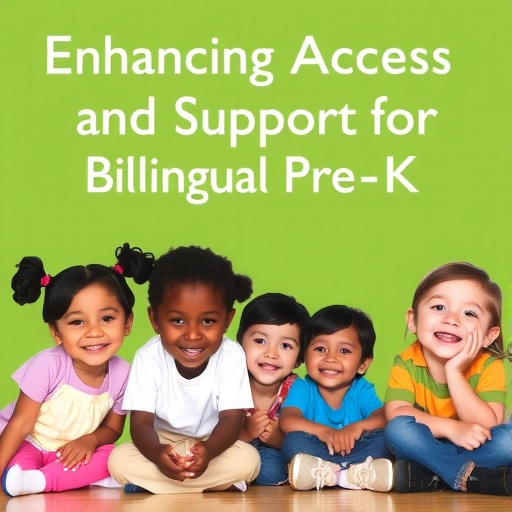In the rapidly evolving educational landscape of New York City, a critical focus has emerged around the accessibility and quality of universal Pre-K programs, especially for emergent bilingual children. These young learners, who navigate the complex interplay between their home languages and English, face unique challenges and opportunities that demand a nuanced understanding from educators, policymakers, and researchers alike. Recent research spearheaded by B.A. Collins casts a revealing light on how these early learning environments serve emergent bilinguals, assessing the extent to which home language support and equitable access are integrated into universal Pre-K offerings across NYC.
Universal Pre-K programs represent one of the most ambitious early childhood education initiatives in the United States, aiming to provide comprehensive educational foundations for all four-year-olds regardless of background. However, emergent bilingual children—those acquiring English in addition to their home language—encounter distinct hurdles that potentially undermine the intended universality and inclusiveness of these programs. The research delves into whether such educational settings truly accommodate linguistic diversity or inadvertently marginalize non-English speakers.
Central to Collins’ analysis is the concept of “access,” which encompasses not merely enrollment statistics but also the quality and suitability of the educational experience offered to emergent bilinguals. Access in this context implies that these children not only physically attend Pre-K but also receive pedagogical support that recognizes and respects their bilingual identities. The study interrogates systemic barriers, such as socio-economic factors, availability of bilingual educators, and geographic disparities in funding, which collectively shape access equity.
Quality in early education transcends curriculum content; it encompasses teacher qualifications, classroom environment, and instructional methodologies that foster cognitive and linguistic development. For emergent bilinguals, the quality metric is inseparable from how well programs incorporate home language support. Collins’ work highlights that many universal Pre-K classrooms remain predominantly English-centric. This often neglects the rich linguistic resources emergent bilinguals bring, potentially leading to slower language acquisition and attenuated academic progress.
The concept of home language support is meticulously examined in the study. Home language maintenance is not a mere cultural preservation effort but a strategic educational component critical for dual language proficiency, cognitive flexibility, and identity affirmation. The research underscores that effective Pre-K programs model inclusive practices, such as the use of instructional materials in multiple languages, family engagement strategies that encourage home language use, and teacher training focused on bilingual education pedagogy.
In striking a balance between accessibility and quality, universal Pre-K programs confront structural and pedagogical challenges. The research sheds light on policy limitations that prioritize universal enrollment without corresponding investment in linguistic resource allocation. This misalignment inadvertently compromises the developmental trajectories of emergent bilingual children, who require a more tailored educational approach that integrates their linguistic repertoires into learning objectives.
Considering demographics, NYC’s unique linguistic mosaic—with families speaking dozens of different languages—creates an urgent imperative for Pre-K programs to pivot from monolingual to multilingual frameworks. The data reveals that emergent bilinguals constitute a significant proportion of the Pre-K population, yet systemic supports lag, exposing a gap between policy intentions and educational realities.
Collins’ work also explores innovative programmatic efforts within certain districts that exemplify best practices in bilingual education. These include models that blend dual-language immersion, explicit language development goals, and family partnership initiatives that validate and leverage home language skills as assets rather than obstacles. Such initiatives demonstrate promising outcomes in early literacy, socio-emotional development, and long-term academic success.
The study brings attention to the critical role of educator preparation and professional development. Professional learning environments that equip teachers with skills to navigate bilingual classrooms effectively are pivotal. One finding emphasizes that teachers often feel underprepared to address the needs of emergent bilinguals, reflecting a gap that training programs must urgently fill to ensure educational equity.
In addition to classroom-level interventions, Collins advocates for systemic reforms that realign funding priorities to support comprehensive language services and culturally responsive teaching materials. This systemic approach is vital to bridging the structural inequities that perpetuate disparities in Pre-K education quality and access for emergent bilingual populations.
Family engagement emerges as another cornerstone of educational strategies highlighted in the research. Successful programs actively involve families in the learning process, recognizing parents and caregivers as partners who reinforce home language use and cultural identity. This reciprocal relationship builds trust and fosters sustained educational support beyond the classroom walls.
The findings also touch upon technological integration as a supplemental avenue for enhancing home language support. Digital tools designed for bilingual learners can provide practice opportunities and resources that might not be available in low-resource classroom settings, thus offering scalable solutions for large urban districts.
Collins’ comprehensive approach provides a mapped pathway for policymakers, educators, and community stakeholders to re-envision universal Pre-K as truly universal—embracing linguistic diversity and fostering equitable educational outcomes. The research stresses that embedding home language support within high-quality Pre-K frameworks is not optional but essential to realizing the promise of early childhood education as a catalyst for lifelong academic success and social inclusion.
Ultimately, the study serves as a clarion call to redefine educational equity for emergent bilingual children in one of the world’s most linguistically diverse urban centers. It challenges existing paradigms and encourages innovation, investment, and inclusive policy-making to build foundations that honor every child’s linguistic heritage while preparing them for a bilingual, multicultural future.
In sum, B.A. Collins’ research offers an urgent and insightful examination into the ways NYC’s universal Pre-K system can better serve emergent bilingual learners. By intertwining critical analyses of access, quality, and home language support, this work sets a new standard for what equitable early education should look like in vibrant, multilingual urban contexts.
Subject of Research: Access, quality, and home language support for emergent bilingual children in New York City’s universal Pre-K programs
Article Title: Access, quality, and home language support for emergent bilingual children in NYC’s universal Pre-K programs
Article References:
Collins, B.A. Access, quality, and home language support for emergent bilingual children in NYC’s universal Pre-K programs. ICEP 19, 19 (2025). https://doi.org/10.1186/s40723-025-00159-w
Image Credits: AI Generated




